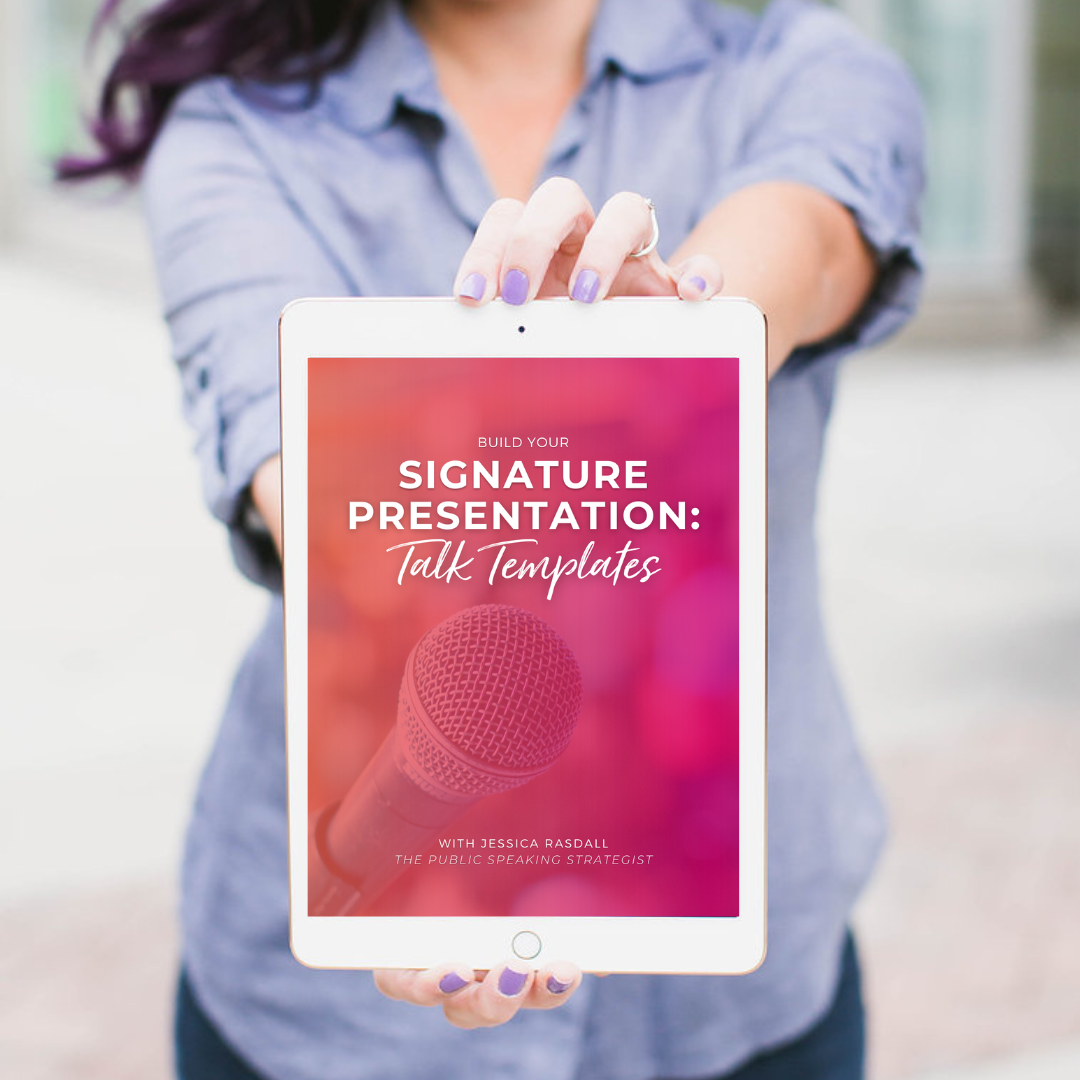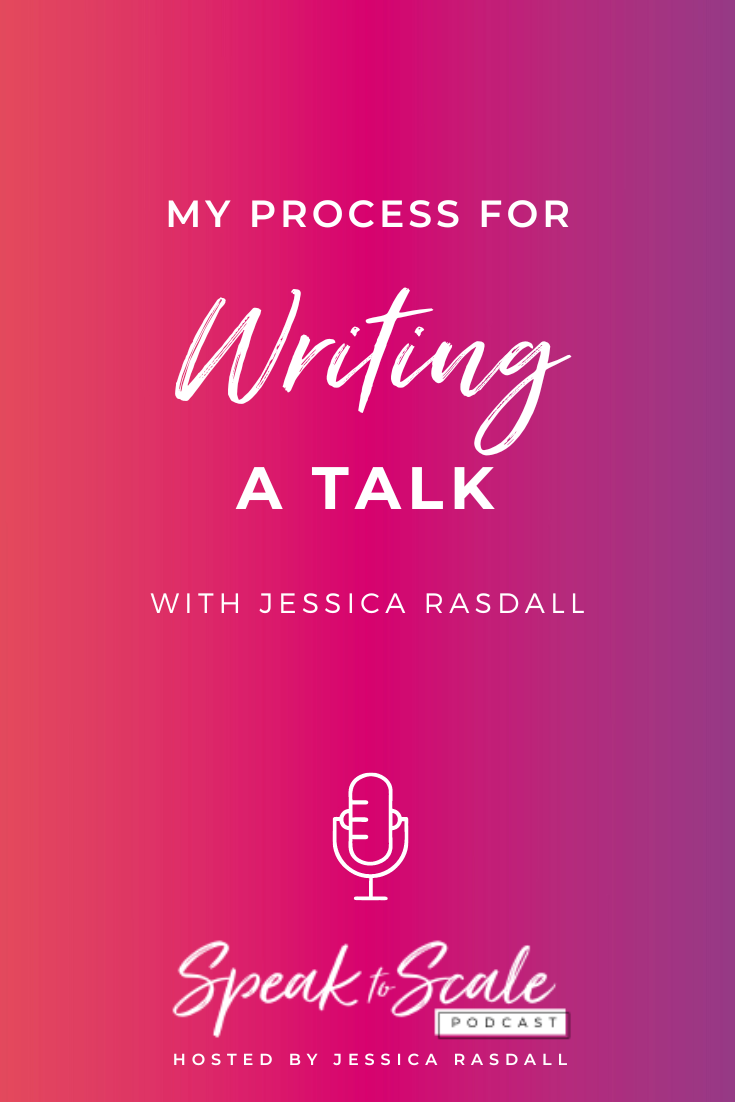209: When Writing a Talk is Too Hard: How I Write a Speech
When it comes to writing your talks, how do you feel? Maybe you love delivering your speeches onstage, but writing them down beforehand feels like torture. Or, maybe you love creative writing, but channeling your creativity into a structured, strategic presentation feels impossible.
I’ve been there, folks. Writing a talk from start to finish can be tough! So, let’s go behind-the-scenes today, where you’ll learn how I craft talks for my clients.
If you loved this episode, I’d love for you to leave a review on iTunes and tell me about your biggest takeaway. Take a screenshot of you listening on your device, post it to your Instagram Stories, and tag me @jessicarasdall.
What my first talk was actually like
Quick storytime first. I wrote my first talk in 2006 when I was nineteen years old. Yep, nineteen! I had no strategy. I just wrote what was in my heart and to get a few key ideas out of my brain and onto paper.
When writing this talk, I asked myself:
What do I want my audience to walk away with?
What impact will I leave on them? In a perfect world, how would my presentation change them or their lives?
Why might someone not receive this talk well? What might get in the way for them?
How can I put myself in their shoes? (Remember, empathy! [MARCH WEEK 2 BLOG]) How can I put them in mine?
That’s all, folks. No structure. No plan. Just a laser focus on the difference this talk would make. Not for me, but for my audience.
And you know what? This talk was more impactful than I ever could have imagined. I delivered it on hundreds of stages and shared my message on dozens of international major media outlets. I didn’t write a new talk in the years to come, either. What I did was collect feedback and data on this talk. I tweaked it and honed it in, aiming to make it 1% better every time I delivered it.
Get started — then get better
Am I telling you to do exactly what I did and write your talk with all heart and no strategy? Of course not! I just want you to remember that you have to get started in order to get better.
You won’t know what you’re doing really well and what you can improve until you get onstage and deliver that talk. You won’t know what jokes will land or what parts of your story will really resonate with your audience. You won’t know what feels good for you on the stage and what doesn’t.
My mentor always used to tell me that there are three talks: the talk you planned to give, the talk you actually gave, and the talk you wish you gave. And he was right!
So, be aware of how your speech changes onstage. Keep in mind what you want to improve. You can implement those changes before your next speaking engagement, but only after you’ve got a clear plan in mind.
How I write a speech for my clients
I often learn things by understanding how other people approach the same action or task. So, I thought I’d give my process for writing a done-for-you talk for a client.
At minimum, I take three passes at writing a talk. Sometimes it’s closer to five or six. This is what happens during each passthrough:
Pass #1: Storyboard. I interview my client and pull out responses to use in their talk. I add them to a storyboard to get a high-level view of what’s in the talk and in what order. This pass is a blend of strategy and creativity.
Pass #2: Outline. After the storyboard is approved, I move on to the outline, where I lean heavily on strategy and structure. What needs to be said and in what order for this to work? The storyboard content is put into our signature presentation template. (Yes, the exact one you can get from the Speak to Scale Shop!)
Pass #3: Finishing touches. Once all of the core content is in the talk outline, I step away, then come back with fresh eyes. This helps when I add all of the creative details. Stories, anecdotes, analogies, transitions, audience exercises. The icing on the cake that pulls the entire talk together. I write the opening of the talk here, too.
From here, I work on the slides. Because, while your talk may feel perfect in writing, it might need a few tweaks when you’re designing your slide deck to support it. I take another pass at the talk from start to finish to ensure it flows with the slides as intended.
After all the passes are complete, I hand it over to my client and have them do a run-through to see how it feels. It’s like trying on a wedding dress or doing a dress rehearsal. What can be improved? What needs to be fixed? How does practicing the talk feel?
There you have it. Three passes at minimum, each focusing on your overall story, then strategy, then creativity. I find that this process works best for me and also my clients. I know it can work for you, too.
Get more help writing your next talk
Once you understand how to craft a great talk, it becomes much easier to take what you’ve written and adapt it for various topics, audiences, or platforms. With this process, you can adapt a keynote speech into podcast episodes, blog posts, or YouTube videos. Turn your workshop into a webinar. Break down a presentation into talking points for an interview. See what I mean?
No need to start from scratch every time. No more time wasted staring at the blinking cursor of death in your Google doc.
But say you’re looking for a little more guidance in writing your talk. You’re not sure whether your strength is creativity or strategy. (Or if it might be a bit of both like me!)
Our Build Your Presentation: Talk Templates in the Speak to Scale Shop includes two different approaches for writing your talk that get you to the same goal.
Are you a creative right-brained speaker who needs help putting your ideas into a clearly structured, well-planned talk? Our Storyboard Training has you covered. Are you a logical left-brained speaker who needs help with their creativity? Our Plug-and-Play Templates take care of it all.
No matter your writing style, we’ll help you write your talk from start to finish. Get going on your next talk with Build Your Presentation: Talk Templates!
Loved this episode? follow us on Pinterest and pin it for later!
Other related episodes you’ll love
*Affiliate links may be included above. However, we only share resources with you that we personally use and love!












